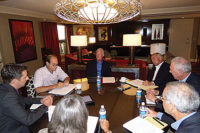In September, a blue-chip group of six PHCP-PVF distributors gathered in Las Vegas at the Bellagio for the fifth-annual Supply House Times-American Supply Association roundtable interview.
In our December issue, which featured Part 1, the group expressed its thoughts and opinions on topics such as succession planning, innovation and issues related to the current economy. This time, the group ramps up its discussion even more with a lively exchange regarding such subjects as hiring practices, health-care concerns, water-heater regulations and opinions on the current state of ASA.
Participants in the 90-plus-minute exclusive interview conducted during the record-breaking NetworkASA 2014 event, included:
· Ted Green, CEO of Rohnert Park, Calif.-based Pace Supply;
· Karla Neupert Hockley, President of Tigard, Ore.-based Consolidated Supply Co.;
· Scott Robertson, President of Alliance, Ohio-based Robertson Heating Supply;
· Brian Tuohey, President of East Windsor, Conn.-based Collins Pipe & Supply;
· Scott Weaver, President of Lebanon, Pa.-based APR Supply; and
· Sam Williams Jr., President of Columbia, S.C.-based Gateway Supply.
Question: Are you looking to add to your staff in the coming year and if so where are you going about finding new hires?
Panelists revealed a variety of strategies concerning staff expansion with mitigating factors in the process centering on forthcoming retirements, caution because of the recent recession and hiring on potential.
“There are too many people with institutional knowledge retiring in the industry,” Neupert Hockley said. “We have to add staff just to sustain. Organically training new employees has to happen more quickly. Before, it might have been five years and now that training has to happen within two years in order to remain relevant and service our customers effectively.”
Williams Jr. is taking advantage of the talent pool from nearby military bases in the South Carolina area. “We’re being very selective with hiring in our market,” he said. “We probably have 10 or 12 veterans from the area. These are really good people. They are smart and they are willing to do and learn. We want to make sure they are able to move forward.”
Weaver noted APR Supply is cultivating talent through its manager training program. “We’re hiring college graduates to go into a two-year program,” he explained. “They do jobs for three months to a year at various locations in the company. When they are done they can become a location manager. We also have a young leaders program where 20 people meet once a month and spend the day creating. We’re showing them the path of what our growth plans are and where you fit into those plans. It has very high potential.”
Collins Pipe & Supply’s Tuohey deals heavily in the industrial PVF market and has seen a generational shift that has forced a new approach with hiring. “There definitely is a skills transference occurring in our industry,” he said. “Manufacturers are by intention transferring that requirement. Fifteen years ago we had no engineers on staff. Today we have 10 and about half our new hires either are mechanical or electrical engineers. It’s become a requirement of the marketplace and it’s a good requirement because it increases our industry’s value proposition.”
Green and Pace Supply have put a lot of thought into the future when it comes to hiring based on recent past experiences.
“We are hiring more for potential than knowledge,” he said. “We did a push to hire sales staff through the colleges and it gave us an education that we weren’t prepared for it. College graduates have expectations. You need to set short- and long-term goals for them to meet. We were losing more than half our college-graduate trainees because they were frustrated with us. Now, if we hire someone for the warehouse they have to have the potential in their personality to go to the counter or at least inside sales.”
Finally, Robertson noted the aftermath of the recent financial upheaval still factors into his company’s hiring decisions. “We’re still being careful,” he said. “The pain and memory of layoffs and time off five years ago still lurks. You want to be really sure you need that extra position. With moderate sales growth and profitability not setting all-time records, you must be careful.”
That thoroughness for Robertson involves an added emphasis on training. “For example, we stepped it up with a counterperson’s skills test,” he said. “We developed a test where a counterperson gets on the computer and performs a task and we make sure he or she can do it. If we see someone can’t do a manufacturer debit memo online, we tie that to a compensation review. We’ve gone from subjective training to very objective training.”
Question: How has your company dealt with recent new regulations, particularly concerning water heaters?
California-based Pace Supply is taking a proactive stance with the new water-heater regulations that go into effect in mid-April via the National Appliance Energy Conservation Act.
“With water heaters we’re on the cutting edge of all changes taking place,” Green said. “We have created a team within the company where there are three fulltime people and we’re adding another one to make sure — especially with the commercial ones — that new water heaters will meet the requirements in the replacement situation. There is no way plumbers by us can keep up with the different county codes. The new 40-gal. heater won’t fit in a typical closet. On the commercial side the need for air draw is so massive that if it’s not installed in the right place you will burn up the heater. There is so much going on. The law changes things for installers.”
Williams Jr. said at the time of the interview his company was planning on double-stocking water heaters. “Plans to buy present-day heaters go away April 16,” he said. “It’s the same with 13-SEER air-conditioning. Everybody is buying up 13-SEER in our market because we’re faced with 14-SEER. It’s OK to make a change, but when there are limitations on what you can sell or you have a short window to sell it, that’s kind of crazy.”
Neupert Hockley picked up on Williams Jr.’s last thought. “A rolling change will be helpful,” she said. “With low-lead, the music stopped and you had leaded product in a time of recovery. Small and large businesses had to eat a product installed for decades. This rolling change where nobody is harmed — while full of challenges — will be much better.”
Robertson added: “The downside here is the wholesaler faces the issue of rolling the dice. Our customers want us to have inventory, but how much do you buy upon a phase-out? If you are too aggressive you get stuck with inventory after the train has left the station. With the no-lead we all had to discard that for scrap and that hurts. It comes off the bottom line. Our customers and vendors didn’t participate in that. Someone needs to develop a reasonable phase-out period. Maybe six months to sell? What is a fair period of time to see a wholesaler run through normal inventory?”
Question: What specific issues in Washington give you heartburn?
This discussion started out with chats about the continued threat of LIFO repeal and the need for sales-tax reform, and ended with a discussion about health-care cost concerns for distribution companies.
“In my opinion, health care is not in a healthy place for small businesses in the United States right now,” Neupert Hockley said. “We have no idea the ripple effect it will create and the challenges that are before us.”
Tuohey added: “For us, I think we’ve been blessed that for now we have been able to keep pace with the escalating costs, but our customers are the real wild card here. Can they financially auger with these new or dramatically increased expenses? Health care reaches a lot farther than we think it does.”
Green stressed further employee education is needed when it comes to the current state of health care in the country.
“I think most employees don’t understand the ramifications of the health-care change,” he said. “We as business owners are in the meetings with the brokers and agonize over how the plans change and what we have to pay and what the employees have to pay. We have an annual meeting with employees about this. Last year we put up numbers from the last 10 years up to current day of what we paid as a company and what the employees paid as individuals or families. You are looking at eyes that have no idea how big the bill really is. I have breakfast with a small group of small businessmen in the area and when you are talking to guys who have 50 or less employees, they are really struggling with the health-care issue. It’s hitting them harder.”
Robertson noted the current health-care situation has to be taken into consideration when making new hires. “We educate our managers on the cost of insurance and how difficult it is to hire an employee who makes less than $18 an hour,” he explained. “In that area, our share of insurance could be $12,000 a year. You divide $12,000 into a salary of $32,000 to $34,000 a year and that one fringe benefit is about a third of what we pay in compensation. You are seeing restaurants now taking employees down to 30 hours or less because they can’t afford to pay a worker who qualifies for insurance. It’s upside-down for those people in that $15-$20 an hour range.”
Green pointed out an even bigger worry on the health-care front may be lurking around the corner in several years. “The big nightmare in all of it is the ‘Cadillac’ issue takes effect in 2018. This isn’t being addressed by Congress,” he said. “You are talking the dollars you are paying for a good insurance plan for employees. By 2018, it’s considered a ‘Cadillac’ plan and that means you pay 40% penalty charge on anything over the base and so does the employee. So far, it’s been ignored by Congress. The broker explained it to us. You as an employer get fined and so does your employee. They will come back asking you for more money to cover the expense.”
Question: What is your opinion on where ASA is right now as an industry association?
Williams Jr., said the ASA of today looks nothing like the ASA of yesterday. “So many small distributors were turned off for years because the big guys were dominating the regionals and ASA,” he said. “Things have changed. Come and try it. It’s not the way it used to be.”
Green added: “Look what ASA has done over the last 10 or 15 years. They have changed themselves. They took a step back, evaluated and have made changes and have been innovative.”
Several distributor panelists cited the inroads ASA has made in education as a major reason for the association’s revival. “If you only took one of the ASA education courses and stepped back, how long would it take you to produce a course and produce a quality one?” Robertson asked. “Would it ever get done? ASA offers a set of tools, resources and opportunities you can’t get on our own.”
Green added: “ASA has taken a leadership role on the education side and that has helped a lot of wholesalers who have struggled to get this process in place. The ASA Education Foundation is something in the industry that was needed for a long time.”
Neupert Hockley noted the association’s commitment to taking an active role on the legislative side has made a major difference for the industry. “We don’t have the power individually,” she said. “But collectively as more than 300 wholesale companies representing more than 250,000 employees, we do have the power. The government has the ability to get into our business and we need somebody to step forward and say that law won’t work as crafted, please hear us out. We have that here with Dan Hilton (ASA’s director of government affairs).”
Weaver sees even more potential for the association to grow. “There are reasons why ASA is growing and prospering and why net membership growth is up three years in a row. There is huge value here. If you are not a member, come and join us. We’ll help you figure it out.”
Neupert Hockley added: “We’re very happy to be part of this association. ASA is much more relevant now. Manufacturers have come back, buying groups are part of us…ASA has a role for all of us. The energy is back and it’s growing. And that’s important because we have to stick together to make it through the disruptive times we are in.”
If you didn’t read our December issue, check out Part 1 here.
HELPFUL LINKS:







